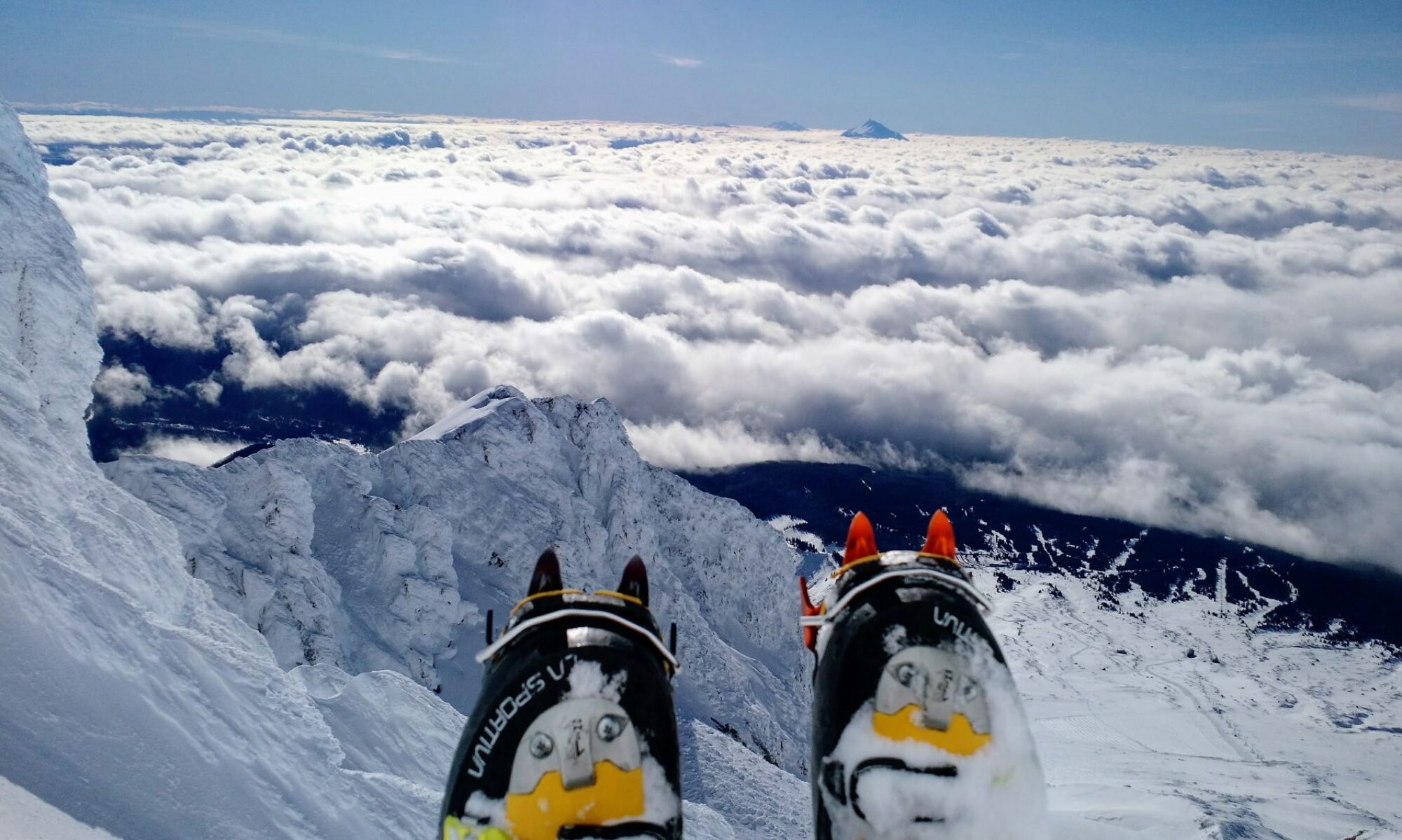 |
|
Negotiating the rubbley slopes of North Sister.
Photo: Kevin Machtelinckx. |
Unless you happened to watch St Helens blow its top, or until you’ve actually been up one, Cascade volcanoes telegraph permanence. At the very least, they look pretty solid. Maybe it’s that classic pyramid shape like the one on the back of a dollar bill that suggests solidity. Broad-shouldered enough to support massive rivers of ice, they must be made of tough stuff. But when you get up there and hit that band of cruddy stuff below Broken Top’s summit block, you start to wonder. How do these things even stand up if they’re filled with junk like this?
The stuff these mountains are made out of is actually quite hard: the andesite and rhyolite making up the bulk of the big peaks is chemically the same material as granite and diorite (which, to the untrained eye, looks like granite.) They come from the same magma, the only difference being where they cooled; the former above ground and the latter below. These are mixes of quartz and other tough minerals baked together at intense temperatures and pressures deep in the earth and then fused in post-eruption cooling. So why all the cruddy rock? Weathering is the short answer. Rain, glaciers, and the freeze-thaw cycle that pries cliffs and boulders apart all take their toll. Another threat comes from what put those rocks there in the first place: the volcano itself.
 |
|
Mineral content of volcanic rocks. Credit:
The Earth Through Time, 8th Edition, Harold Levin. |
Big fire mountains don’t just snuff out like a candle. While volcanoes can take tens of thousands of years to go extinct, the pools of magma that feed them can take millions of years to cool into solid granite and diorite. After a mountain stops erupting new lavas, it can chuff away for a very long time. And it’s that chuffing that really does damage to the hard minerals that make up the rock. How so?
There are those who like to point out that Mt. St. Helens is one of the biggest sources of hydrogen sulfide pollution in the Pacific Northwest. All volcanoes emit it to some degree or another. It’s the gas that makes the trek into Mt. Hood’s crater such an aromatic, and at times irritating experience. Cook andesite and rhyolite long enough with hydrogen sulfide and it turns to mud—technically clay. Hence the gloppy stuff that sticks under your crampons in Hood’s crater—hard to believe, but this essentially started out as granite. Once eruptions of hard new lavas end, hydrogen sulfide can continue to vent long enough to turn a mountain’s innards to mush. So, while glaciers and other elements are gnawing our volcanoes from the outside, volcanic gasses are slowly digesting them from the inside.
 |
| Basalt at 6,500 feet in the Goat Rocks. Photo Darrin Gunkel. |
It doesn’t help, either, that not all lavas are created equal. Ever wonder how basalt, the resilient rock that forms headlands like Cape Lookout, could flow 375 miles from its source in Idaho to reach the sea? And why do rhyolite and andesite pile up to 14,410 feet (Rainier actually maxed out at 16,000 feet before the most recent glaciations shaved it down)? Lava viscosity is dictated in part by how much silica it contains. Basalt is on the low end, and rhyolite the high end of the silica content scale. Sticky rhyolite erupts very differently than fluid basalt. It has a tendency to explode, shattering nearby rocks and itself, raining down in fragments. That, or it erupts cascades of rubbley clinkers, the kind of ankle breakers that make late season climbers on the Sisters wish they’d scheduled their climb before the snows melted.
We owe big thanks to andesite for cementing it all together. Andesite lands between rhyolite and basalt on the silica and viscosity spectrums. Tough andesite is what allows our big mountains to soar and provides nice, solid layers full of fabulous holds among those bands of weaker rock. Erosion resistant basalt makes the occasional appearance, too. Check out the post piles along the Pacific Crest Trail near Cispus Pass in Goat Rocks to see a fine example of the relatively rare high altitude basalt flow. Without the help of andesite and basalt, summiting our slag heaps would be an even bigger, if no less rewarding, chore.
Want to dive deeper into the subject? Fire Mountains of the West, the Cascade and Mono Lake Volcanoes (Mountain Press Publishing Company, 2005) by Stephen Harris is a great primer on the geology of Cascade volcanoes, including biographies of the major peaks. If you can find it, the original version, published by the Mountaineers as Fire and Ice: The Cascade Volcanoes, is an even better read with better graphics. And for a more general back grounder on Pacific Northwest geology, try Hill Williams’ The Restless Northwest, a Geological Story (Washington State University Press, 2002).
About the author: A Mazama since 2013, Darrin Gunkel moved to the Pacific Northwest in 1993 with nothing in his car but camping gear, a pair of binoculars, and a copy of Fire Mountains of the West: the Cascade and Mono Lakes Volcanoes. A mania for up close views of volcano geology and access to dark night skies propel much of his climbing.


